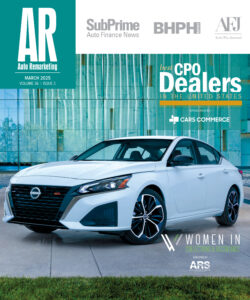Webb: Dealers Cash in Tidy Profits Thanks to Used Vehicles

Along with delving into the usual discussion about the wholesale market and the Manheim Used Vehicle Value Index, Tom Webb stressed how fertile the used-vehicle retail business is for dealers nowadays — especially in light of a wobbly national economy.
“As many of you know, my overall interpretation of the economic environment has been rather pessimistic. It remains that way,” Webb declared during his quarterly conference call Thursday.
“But I’m very optimistic in terms of what’s going on in the used-vehicle retail side of the business. As you all know, the dealers themselves are making good money in a relatively soft market. As the economy continues to improve — and I do believe it will continue to improve, just not very rapidly — they’re going to make even better profits,” he went on to say.
Prior to making those claims, Webb touched on what he believes is a misconstrued connection between new and used vehicles.
“In some respects, I think it’s misleading to get concerned about some relationship of new-vehicle pricing to used-vehicle pricing,” Webb stated. “The more important component as we all know in both markets is monthly payments.
“For example if a (manufacturer’s captive finance company) were to put out a $199 a month lease deal with no money down and offer it to people with low FICO scores, certainly late-model used vehicles of the same make and model are not going to fare well at all,” he explained. “What we really need to concentrate on is monthly payments and the incentive activity related to that. Certainly that has gotten much better.”
Why Webb thinks that’s gotten better is because new-vehicle inventories remain quite low. Despite Manheim spotting a slight uptick in September, the most recent mark, just above 2 million units, is still well below an industry high of 4 million. It’s also well below Manheim data that goes back to 1985.
“September’s solid, but unspectacular, new-vehicle sales level was achieved with less discounting than is normal for this time of year,” Webb indicated. “And, although inventory levels rose from August, they remain low by historical standards.
“There’s nothing like a heavy new-vehicle inventory to shift the franchise dealer focus away from selling used,” he pointed out. “It obviously frees up a lot of working capital to floor used vehicles, and it makes the selling of those used vehicles much more profitable.”
Webb cited CNW Research information discovered dealer sales of used vehicles increased 1.9 percent in September, bringing the year-to-date gain to 4.7 percent. Webb said dealers are reporting that used-vehicle margins are steady, inventory turns are good, and F&I opportunities are improving.
“Most important for late-model used-vehicle values has been the quick and efficient selling of carryover models,” he pointed out. “GM, for example, reported that, at month end, 75 percent of their inventory consisted of 2011 model-year vehicles. Last year at this time, 70 percent of their stock was carryover models.”
Noteworthy Segment Trends
Webb also highlighted a couple of developments regarding two specific segments during the call.
Webb first mentioned the growing amount of luxury vehicles that now pass through auction lanes. Back in the second half of 2001, the percentage slipped below 10 percent. Last month, it climbed up to 20 percent, just the second time it reached that level or higher in nine years.
“We can expect it to continue in that range for the next couple of years,” Webb noted.
Turning over to compact vehicles, Manheim stressed how much the average mileage on these units has spiked. Auction data revealed the average was a little above 50,000 in January of last year. Last month, it approached 65,000 and settled at the highest point in Webb’s data set, which stretches back to January 2006.
“Obviously, that’s a significant increase,” Webb conceded.
Index Rises Slightly
The September Manheim Used Vehicle Value Index reading came in at 118.9. Webb calculated the reading represented a 0.1-percent increase from August and a 0.3-percent increase over the past year. The mark also was exactly the same as July.
“New unit sales volumes were not spectacular in September, but low inventories, low incentives and smooth model-year transitions meant that wholesale used vehicle values declined less than their normal seasonal pattern would suggest,” Webb explained.
“Higher used vehicle retail sales and improved profit opportunities also supported dealer bidding in the wholesale market during the month,” he added.
Rental, Fleet Analysis
Webb found off-rental vehicles continued to command strong prices in September. He pointed out average mileage at time of sale was down 4 percent from August and down 11 percent from a year ago.
“Given the smooth model-year transition, it is not surprising that off-rental units fared well in the wholesale market in September,” he insisted. “Contrary to the normal seasonal pattern, rental risk units had an increase in price from August to September.”
Moving over to fleet prices, Webb determined they remained at record highs in September.
“The average auction price for an end-of-service midsize fleet car rose from August to September and remained above its year ago level,” he explained. “End-of-service pickup trucks had an even stronger increase in pricing, even after adjusting for lower average miles.”
Healthy Price Gains for Pickups and Vans
September marked strong year-over-year price gains for two segments. Manheim found vans up 8 percent over last year, while pickups were 6.1 percent higher.
“The limited supply of pickups in the wholesale market has kept pricing very strong,” Webb pointed out. Pickups were the strongest segment over both the past three months and the past six months.
“Over the past year, however, vans — especially full-size models — have had the largest price gain,” he added.
Also enjoying a year-over-year rise were SUVs and CUVs, which moved up by 2.5 percent, according to Manheim.
Each car segment in Manheim’s data slid in September. Based on year-over-year comparisons, luxury cars dipped the most at 1.3 percent, followed closely behind by midsize cars at 1 percent. Compact cars almost were flat but settled down just a nudge by 0.1 percent.
“Sports cars have been the weakest segment over both the past three months and the past six months, but that is largely a seasonal pattern,” Webb shared. “Over the past year, luxury cars have been the weakest performer.”

 View The Latest Edition
View The Latest Edition

